Finance in Hospitality: Recipe Cost, Pricing, and BEP Analysis
VerifiedAdded on 2023/04/03
|10
|1546
|78
Report
AI Summary
This report provides a comprehensive financial analysis within the hospitality sector. It begins by detailing the calculation of recipe costs, including ingredients and portioning, and progresses to calculating selling prices to achieve desired profit margins, specifically focusing on an 85% margin. The report then shifts to a case study involving a package deal, assessing total costs, cost per person, and calculating selling prices with a 35% markup. Furthermore, it delves into break-even point (BEP) analysis, determining fixed expenses, cost per unit, and assessing profit levels at the BEP. The report concludes by highlighting the importance of financial tools and techniques for effective decision-making within the hospitality industry, emphasizing cost management, pricing strategies, and BEP analysis for maximizing profitability and achieving business objectives. The report includes detailed calculations and tables to support its findings.
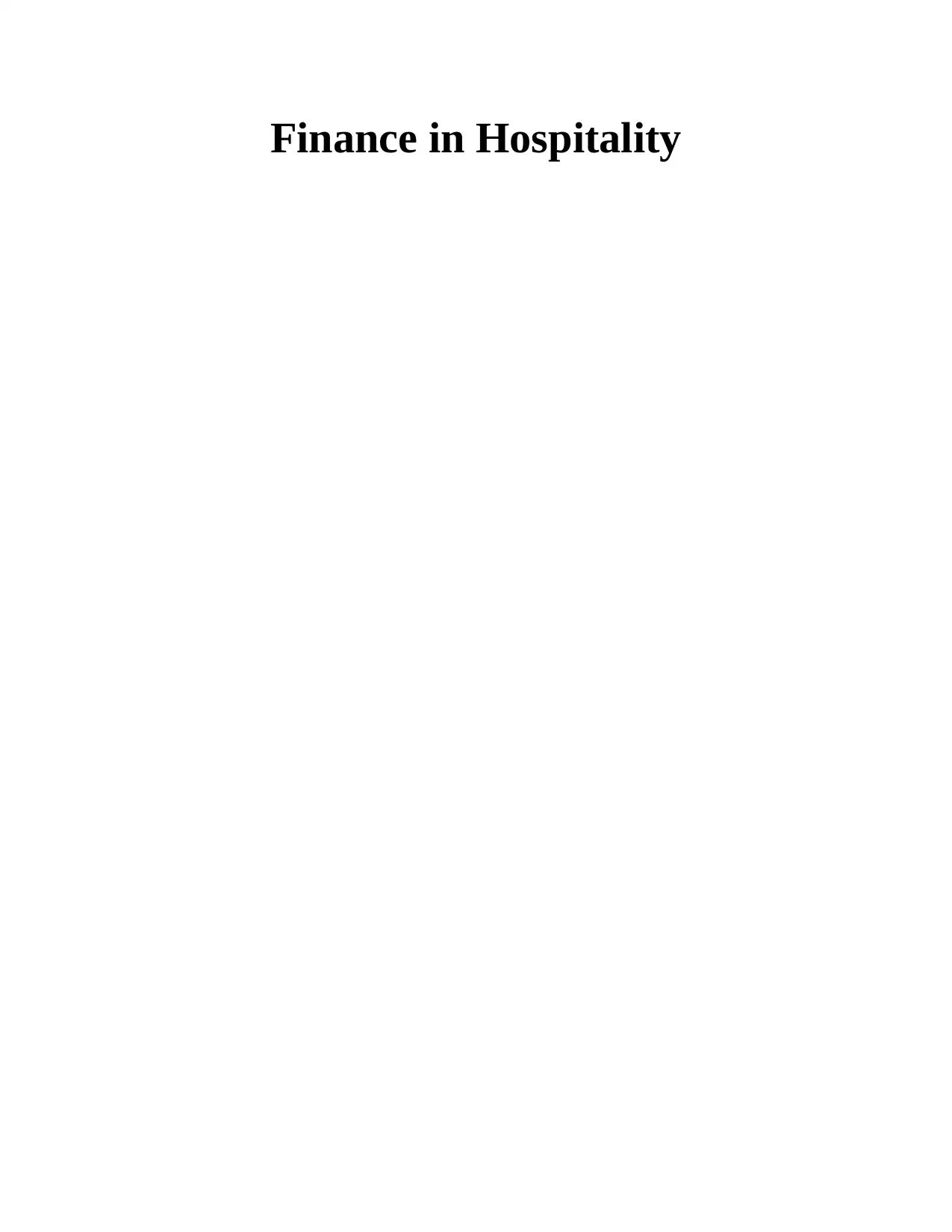
Finance in Hospitality
Paraphrase This Document
Need a fresh take? Get an instant paraphrase of this document with our AI Paraphraser
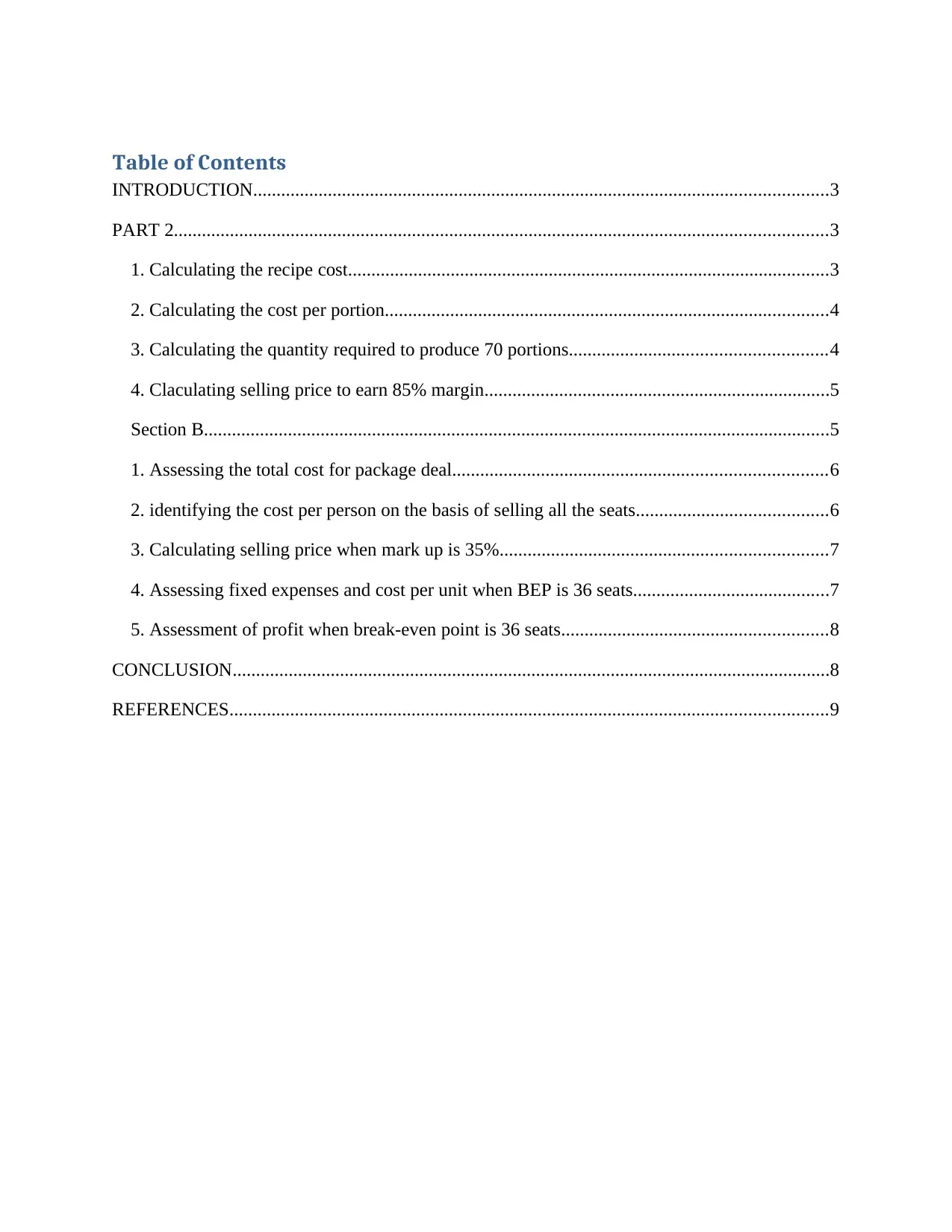
Table of Contents
INTRODUCTION...........................................................................................................................3
PART 2............................................................................................................................................3
1. Calculating the recipe cost.......................................................................................................3
2. Calculating the cost per portion...............................................................................................4
3. Calculating the quantity required to produce 70 portions.......................................................4
4. Claculating selling price to earn 85% margin..........................................................................5
Section B......................................................................................................................................5
1. Assessing the total cost for package deal................................................................................6
2. identifying the cost per person on the basis of selling all the seats.........................................6
3. Calculating selling price when mark up is 35%......................................................................7
4. Assessing fixed expenses and cost per unit when BEP is 36 seats..........................................7
5. Assessment of profit when break-even point is 36 seats.........................................................8
CONCLUSION................................................................................................................................8
REFERENCES................................................................................................................................9
INTRODUCTION...........................................................................................................................3
PART 2............................................................................................................................................3
1. Calculating the recipe cost.......................................................................................................3
2. Calculating the cost per portion...............................................................................................4
3. Calculating the quantity required to produce 70 portions.......................................................4
4. Claculating selling price to earn 85% margin..........................................................................5
Section B......................................................................................................................................5
1. Assessing the total cost for package deal................................................................................6
2. identifying the cost per person on the basis of selling all the seats.........................................6
3. Calculating selling price when mark up is 35%......................................................................7
4. Assessing fixed expenses and cost per unit when BEP is 36 seats..........................................7
5. Assessment of profit when break-even point is 36 seats.........................................................8
CONCLUSION................................................................................................................................8
REFERENCES................................................................................................................................9
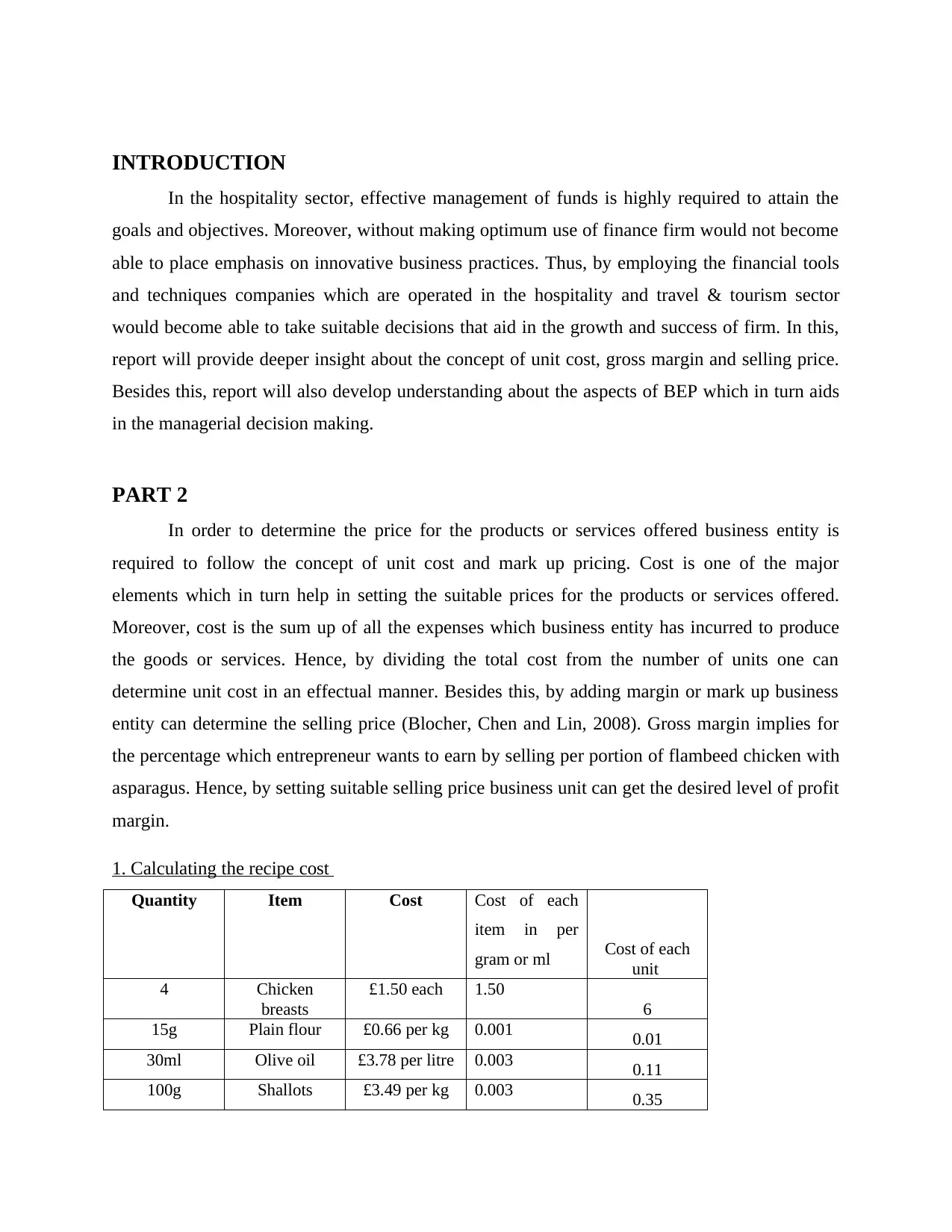
INTRODUCTION
In the hospitality sector, effective management of funds is highly required to attain the
goals and objectives. Moreover, without making optimum use of finance firm would not become
able to place emphasis on innovative business practices. Thus, by employing the financial tools
and techniques companies which are operated in the hospitality and travel & tourism sector
would become able to take suitable decisions that aid in the growth and success of firm. In this,
report will provide deeper insight about the concept of unit cost, gross margin and selling price.
Besides this, report will also develop understanding about the aspects of BEP which in turn aids
in the managerial decision making.
PART 2
In order to determine the price for the products or services offered business entity is
required to follow the concept of unit cost and mark up pricing. Cost is one of the major
elements which in turn help in setting the suitable prices for the products or services offered.
Moreover, cost is the sum up of all the expenses which business entity has incurred to produce
the goods or services. Hence, by dividing the total cost from the number of units one can
determine unit cost in an effectual manner. Besides this, by adding margin or mark up business
entity can determine the selling price (Blocher, Chen and Lin, 2008). Gross margin implies for
the percentage which entrepreneur wants to earn by selling per portion of flambeed chicken with
asparagus. Hence, by setting suitable selling price business unit can get the desired level of profit
margin.
1. Calculating the recipe cost
Quantity Item Cost Cost of each
item in per
gram or ml Cost of each
unit
4 Chicken
breasts
£1.50 each 1.50
6
15g Plain flour £0.66 per kg 0.001 0.01
30ml Olive oil £3.78 per litre 0.003 0.11
100g Shallots £3.49 per kg 0.003 0.35
In the hospitality sector, effective management of funds is highly required to attain the
goals and objectives. Moreover, without making optimum use of finance firm would not become
able to place emphasis on innovative business practices. Thus, by employing the financial tools
and techniques companies which are operated in the hospitality and travel & tourism sector
would become able to take suitable decisions that aid in the growth and success of firm. In this,
report will provide deeper insight about the concept of unit cost, gross margin and selling price.
Besides this, report will also develop understanding about the aspects of BEP which in turn aids
in the managerial decision making.
PART 2
In order to determine the price for the products or services offered business entity is
required to follow the concept of unit cost and mark up pricing. Cost is one of the major
elements which in turn help in setting the suitable prices for the products or services offered.
Moreover, cost is the sum up of all the expenses which business entity has incurred to produce
the goods or services. Hence, by dividing the total cost from the number of units one can
determine unit cost in an effectual manner. Besides this, by adding margin or mark up business
entity can determine the selling price (Blocher, Chen and Lin, 2008). Gross margin implies for
the percentage which entrepreneur wants to earn by selling per portion of flambeed chicken with
asparagus. Hence, by setting suitable selling price business unit can get the desired level of profit
margin.
1. Calculating the recipe cost
Quantity Item Cost Cost of each
item in per
gram or ml Cost of each
unit
4 Chicken
breasts
£1.50 each 1.50
6
15g Plain flour £0.66 per kg 0.001 0.01
30ml Olive oil £3.78 per litre 0.003 0.11
100g Shallots £3.49 per kg 0.003 0.35
⊘ This is a preview!⊘
Do you want full access?
Subscribe today to unlock all pages.

Trusted by 1+ million students worldwide
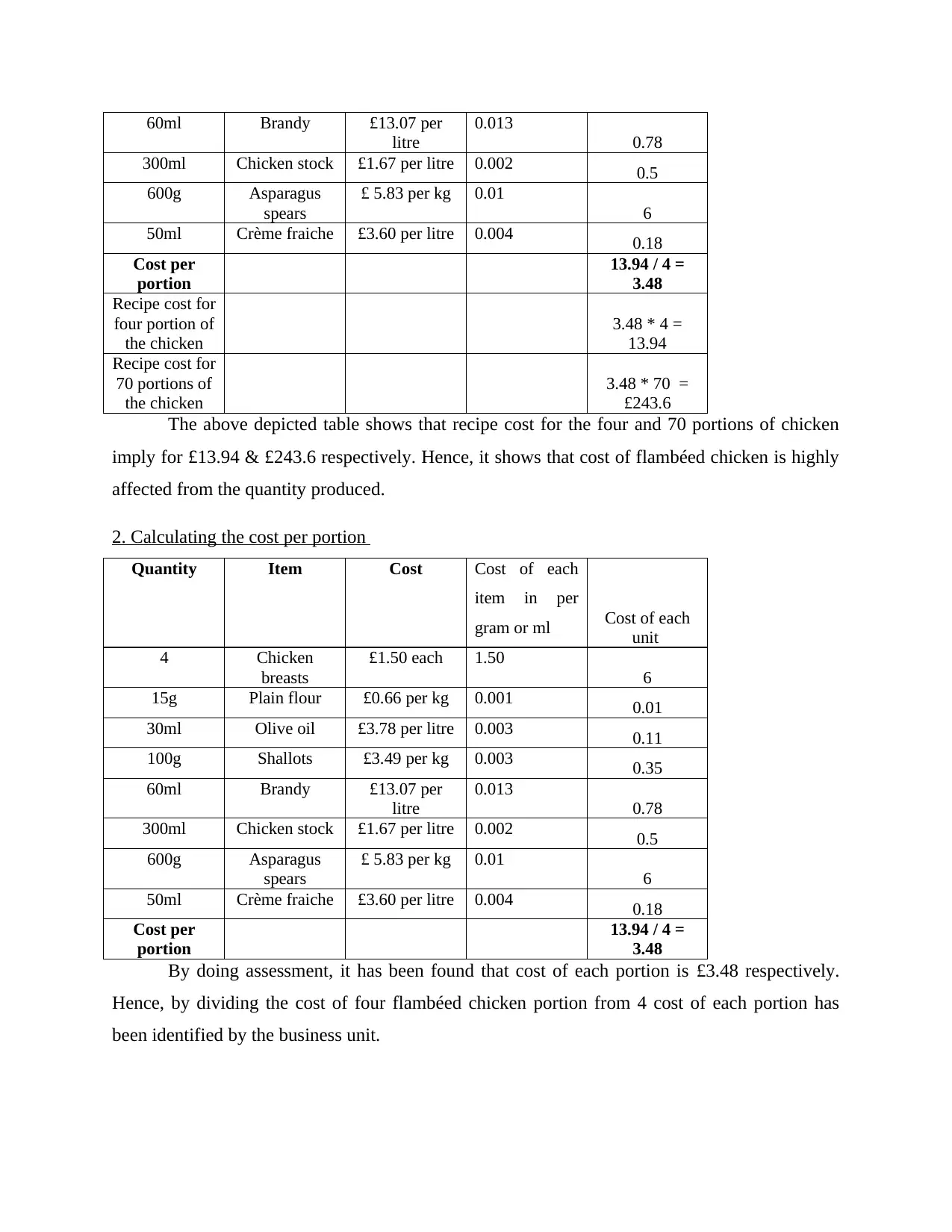
60ml Brandy £13.07 per
litre
0.013
0.78
300ml Chicken stock £1.67 per litre 0.002 0.5
600g Asparagus
spears
£ 5.83 per kg 0.01
6
50ml Crème fraiche £3.60 per litre 0.004 0.18
Cost per
portion
13.94 / 4 =
3.48
Recipe cost for
four portion of
the chicken
3.48 * 4 =
13.94
Recipe cost for
70 portions of
the chicken
3.48 * 70 =
£243.6
The above depicted table shows that recipe cost for the four and 70 portions of chicken
imply for £13.94 & £243.6 respectively. Hence, it shows that cost of flambéed chicken is highly
affected from the quantity produced.
2. Calculating the cost per portion
Quantity Item Cost Cost of each
item in per
gram or ml Cost of each
unit
4 Chicken
breasts
£1.50 each 1.50
6
15g Plain flour £0.66 per kg 0.001 0.01
30ml Olive oil £3.78 per litre 0.003 0.11
100g Shallots £3.49 per kg 0.003 0.35
60ml Brandy £13.07 per
litre
0.013
0.78
300ml Chicken stock £1.67 per litre 0.002 0.5
600g Asparagus
spears
£ 5.83 per kg 0.01
6
50ml Crème fraiche £3.60 per litre 0.004 0.18
Cost per
portion
13.94 / 4 =
3.48
By doing assessment, it has been found that cost of each portion is £3.48 respectively.
Hence, by dividing the cost of four flambéed chicken portion from 4 cost of each portion has
been identified by the business unit.
litre
0.013
0.78
300ml Chicken stock £1.67 per litre 0.002 0.5
600g Asparagus
spears
£ 5.83 per kg 0.01
6
50ml Crème fraiche £3.60 per litre 0.004 0.18
Cost per
portion
13.94 / 4 =
3.48
Recipe cost for
four portion of
the chicken
3.48 * 4 =
13.94
Recipe cost for
70 portions of
the chicken
3.48 * 70 =
£243.6
The above depicted table shows that recipe cost for the four and 70 portions of chicken
imply for £13.94 & £243.6 respectively. Hence, it shows that cost of flambéed chicken is highly
affected from the quantity produced.
2. Calculating the cost per portion
Quantity Item Cost Cost of each
item in per
gram or ml Cost of each
unit
4 Chicken
breasts
£1.50 each 1.50
6
15g Plain flour £0.66 per kg 0.001 0.01
30ml Olive oil £3.78 per litre 0.003 0.11
100g Shallots £3.49 per kg 0.003 0.35
60ml Brandy £13.07 per
litre
0.013
0.78
300ml Chicken stock £1.67 per litre 0.002 0.5
600g Asparagus
spears
£ 5.83 per kg 0.01
6
50ml Crème fraiche £3.60 per litre 0.004 0.18
Cost per
portion
13.94 / 4 =
3.48
By doing assessment, it has been found that cost of each portion is £3.48 respectively.
Hence, by dividing the cost of four flambéed chicken portion from 4 cost of each portion has
been identified by the business unit.
Paraphrase This Document
Need a fresh take? Get an instant paraphrase of this document with our AI Paraphraser
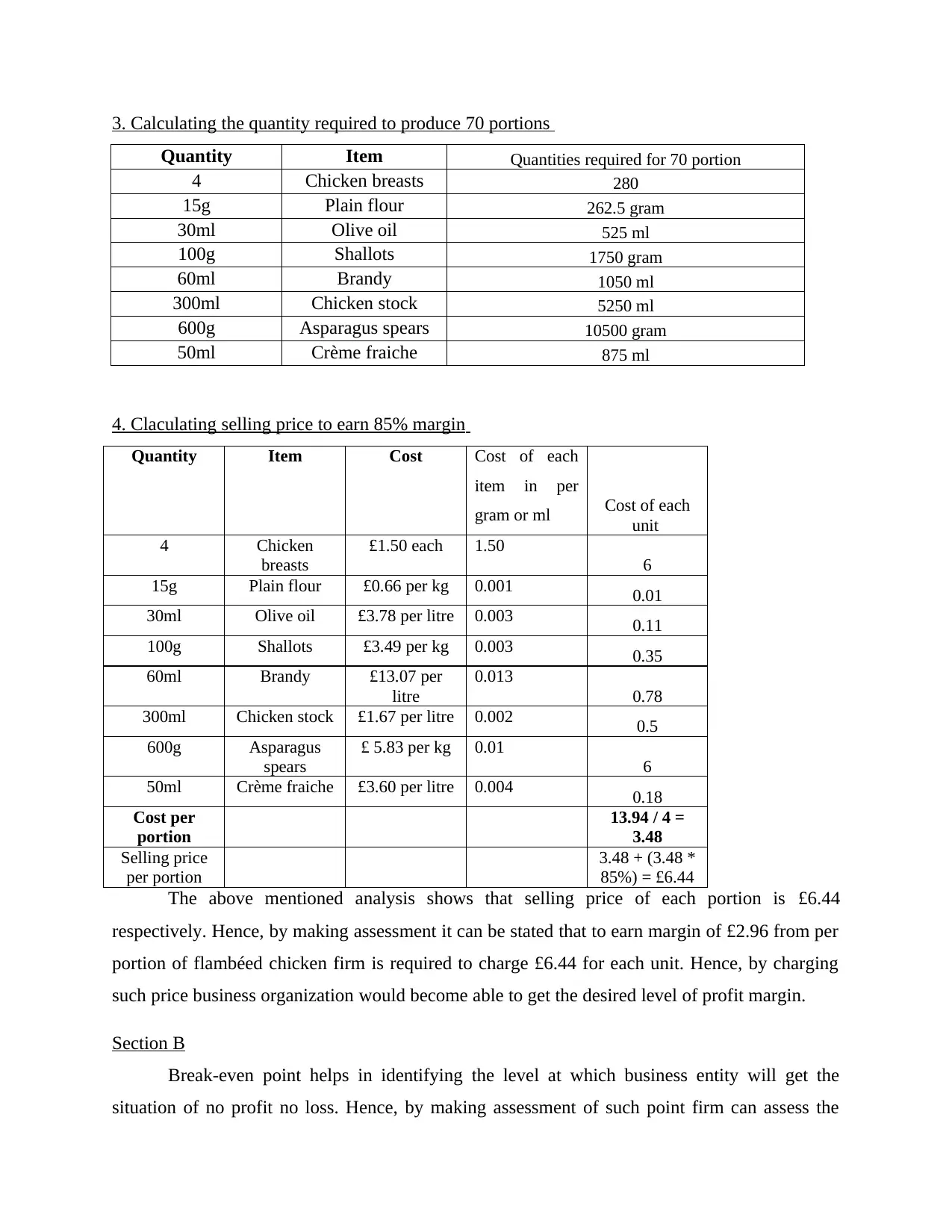
3. Calculating the quantity required to produce 70 portions
Quantity Item Quantities required for 70 portion
4 Chicken breasts 280
15g Plain flour 262.5 gram
30ml Olive oil 525 ml
100g Shallots 1750 gram
60ml Brandy 1050 ml
300ml Chicken stock 5250 ml
600g Asparagus spears 10500 gram
50ml Crème fraiche 875 ml
4. Claculating selling price to earn 85% margin
Quantity Item Cost Cost of each
item in per
gram or ml Cost of each
unit
4 Chicken
breasts
£1.50 each 1.50
6
15g Plain flour £0.66 per kg 0.001 0.01
30ml Olive oil £3.78 per litre 0.003 0.11
100g Shallots £3.49 per kg 0.003 0.35
60ml Brandy £13.07 per
litre
0.013
0.78
300ml Chicken stock £1.67 per litre 0.002 0.5
600g Asparagus
spears
£ 5.83 per kg 0.01
6
50ml Crème fraiche £3.60 per litre 0.004 0.18
Cost per
portion
13.94 / 4 =
3.48
Selling price
per portion
3.48 + (3.48 *
85%) = £6.44
The above mentioned analysis shows that selling price of each portion is £6.44
respectively. Hence, by making assessment it can be stated that to earn margin of £2.96 from per
portion of flambéed chicken firm is required to charge £6.44 for each unit. Hence, by charging
such price business organization would become able to get the desired level of profit margin.
Section B
Break-even point helps in identifying the level at which business entity will get the
situation of no profit no loss. Hence, by making assessment of such point firm can assess the
Quantity Item Quantities required for 70 portion
4 Chicken breasts 280
15g Plain flour 262.5 gram
30ml Olive oil 525 ml
100g Shallots 1750 gram
60ml Brandy 1050 ml
300ml Chicken stock 5250 ml
600g Asparagus spears 10500 gram
50ml Crème fraiche 875 ml
4. Claculating selling price to earn 85% margin
Quantity Item Cost Cost of each
item in per
gram or ml Cost of each
unit
4 Chicken
breasts
£1.50 each 1.50
6
15g Plain flour £0.66 per kg 0.001 0.01
30ml Olive oil £3.78 per litre 0.003 0.11
100g Shallots £3.49 per kg 0.003 0.35
60ml Brandy £13.07 per
litre
0.013
0.78
300ml Chicken stock £1.67 per litre 0.002 0.5
600g Asparagus
spears
£ 5.83 per kg 0.01
6
50ml Crème fraiche £3.60 per litre 0.004 0.18
Cost per
portion
13.94 / 4 =
3.48
Selling price
per portion
3.48 + (3.48 *
85%) = £6.44
The above mentioned analysis shows that selling price of each portion is £6.44
respectively. Hence, by making assessment it can be stated that to earn margin of £2.96 from per
portion of flambéed chicken firm is required to charge £6.44 for each unit. Hence, by charging
such price business organization would become able to get the desired level of profit margin.
Section B
Break-even point helps in identifying the level at which business entity will get the
situation of no profit no loss. Hence, by making assessment of such point firm can assess the
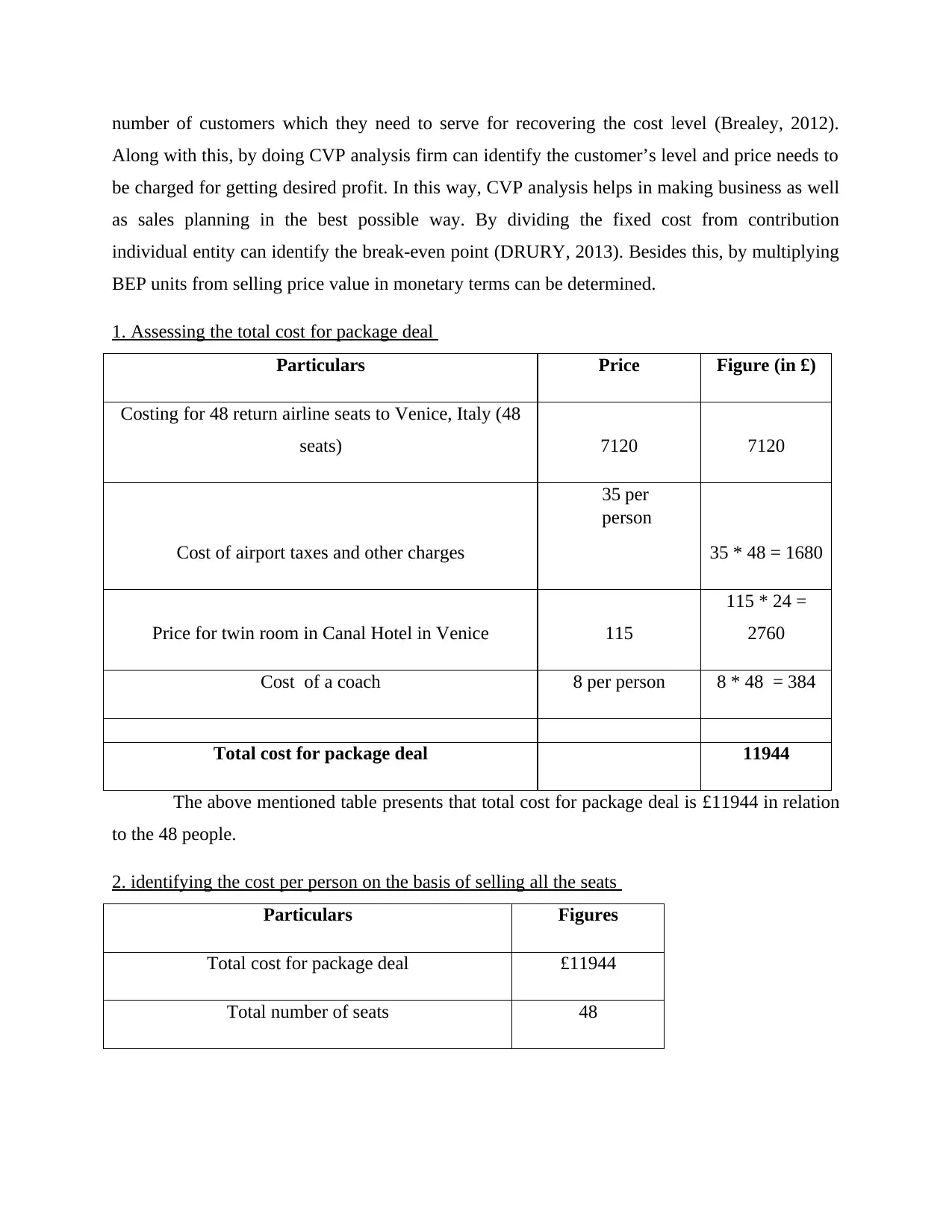
number of customers which they need to serve for recovering the cost level (Brealey, 2012).
Along with this, by doing CVP analysis firm can identify the customer’s level and price needs to
be charged for getting desired profit. In this way, CVP analysis helps in making business as well
as sales planning in the best possible way. By dividing the fixed cost from contribution
individual entity can identify the break-even point (DRURY, 2013). Besides this, by multiplying
BEP units from selling price value in monetary terms can be determined.
1. Assessing the total cost for package deal
Particulars Price Figure (in £)
Costing for 48 return airline seats to Venice, Italy (48
seats) 7120 7120
Cost of airport taxes and other charges
35 per
person
35 * 48 = 1680
Price for twin room in Canal Hotel in Venice 115
115 * 24 =
2760
Cost of a coach 8 per person 8 * 48 = 384
Total cost for package deal 11944
The above mentioned table presents that total cost for package deal is £11944 in relation
to the 48 people.
2. identifying the cost per person on the basis of selling all the seats
Particulars Figures
Total cost for package deal £11944
Total number of seats 48
Along with this, by doing CVP analysis firm can identify the customer’s level and price needs to
be charged for getting desired profit. In this way, CVP analysis helps in making business as well
as sales planning in the best possible way. By dividing the fixed cost from contribution
individual entity can identify the break-even point (DRURY, 2013). Besides this, by multiplying
BEP units from selling price value in monetary terms can be determined.
1. Assessing the total cost for package deal
Particulars Price Figure (in £)
Costing for 48 return airline seats to Venice, Italy (48
seats) 7120 7120
Cost of airport taxes and other charges
35 per
person
35 * 48 = 1680
Price for twin room in Canal Hotel in Venice 115
115 * 24 =
2760
Cost of a coach 8 per person 8 * 48 = 384
Total cost for package deal 11944
The above mentioned table presents that total cost for package deal is £11944 in relation
to the 48 people.
2. identifying the cost per person on the basis of selling all the seats
Particulars Figures
Total cost for package deal £11944
Total number of seats 48
⊘ This is a preview!⊘
Do you want full access?
Subscribe today to unlock all pages.

Trusted by 1+ million students worldwide
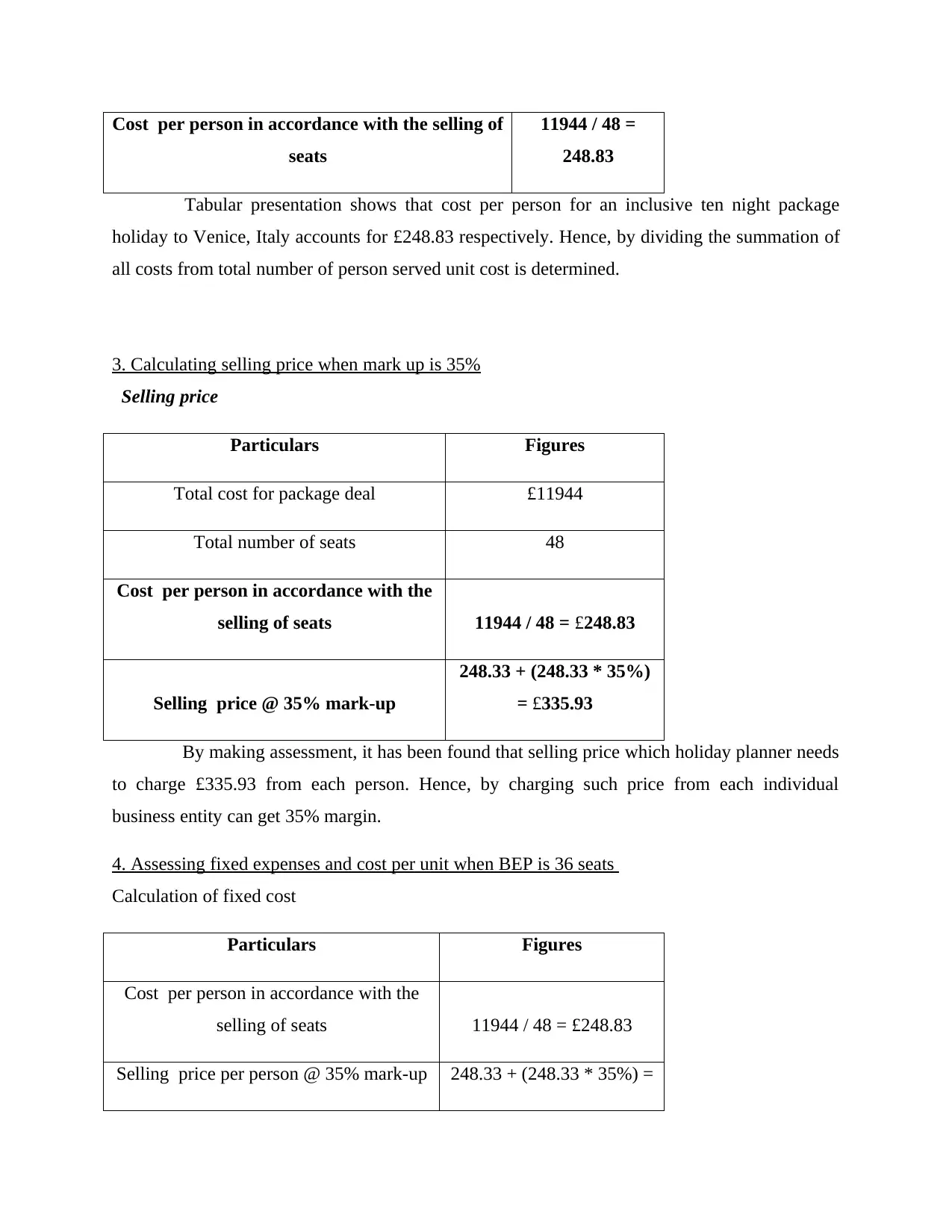
Cost per person in accordance with the selling of
seats
11944 / 48 =
248.83
Tabular presentation shows that cost per person for an inclusive ten night package
holiday to Venice, Italy accounts for £248.83 respectively. Hence, by dividing the summation of
all costs from total number of person served unit cost is determined.
3. Calculating selling price when mark up is 35%
Selling price
Particulars Figures
Total cost for package deal £11944
Total number of seats 48
Cost per person in accordance with the
selling of seats 11944 / 48 = £248.83
Selling price @ 35% mark-up
248.33 + (248.33 * 35%)
= £335.93
By making assessment, it has been found that selling price which holiday planner needs
to charge £335.93 from each person. Hence, by charging such price from each individual
business entity can get 35% margin.
4. Assessing fixed expenses and cost per unit when BEP is 36 seats
Calculation of fixed cost
Particulars Figures
Cost per person in accordance with the
selling of seats 11944 / 48 = £248.83
Selling price per person @ 35% mark-up 248.33 + (248.33 * 35%) =
seats
11944 / 48 =
248.83
Tabular presentation shows that cost per person for an inclusive ten night package
holiday to Venice, Italy accounts for £248.83 respectively. Hence, by dividing the summation of
all costs from total number of person served unit cost is determined.
3. Calculating selling price when mark up is 35%
Selling price
Particulars Figures
Total cost for package deal £11944
Total number of seats 48
Cost per person in accordance with the
selling of seats 11944 / 48 = £248.83
Selling price @ 35% mark-up
248.33 + (248.33 * 35%)
= £335.93
By making assessment, it has been found that selling price which holiday planner needs
to charge £335.93 from each person. Hence, by charging such price from each individual
business entity can get 35% margin.
4. Assessing fixed expenses and cost per unit when BEP is 36 seats
Calculation of fixed cost
Particulars Figures
Cost per person in accordance with the
selling of seats 11944 / 48 = £248.83
Selling price per person @ 35% mark-up 248.33 + (248.33 * 35%) =
Paraphrase This Document
Need a fresh take? Get an instant paraphrase of this document with our AI Paraphraser
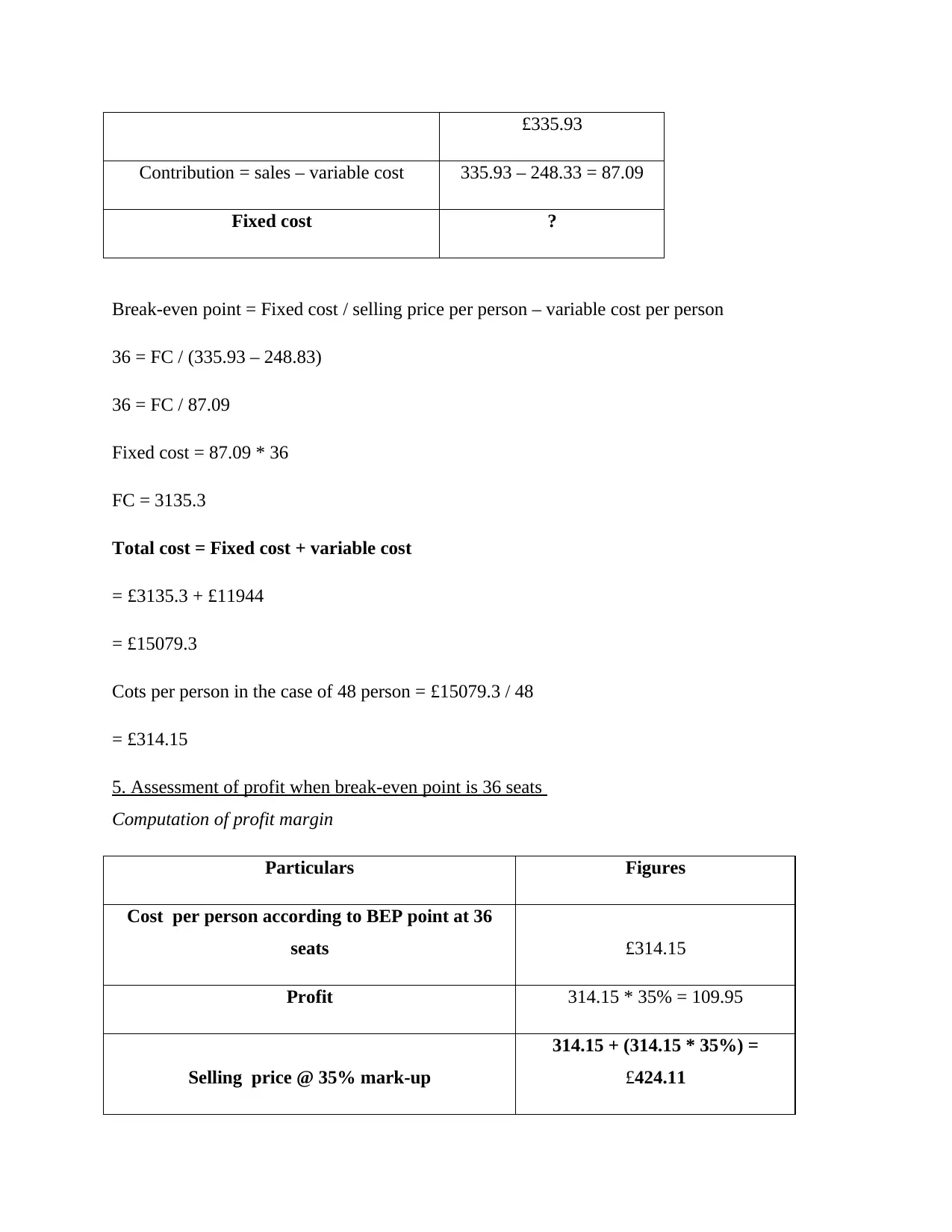
£335.93
Contribution = sales – variable cost 335.93 – 248.33 = 87.09
Fixed cost ?
Break-even point = Fixed cost / selling price per person – variable cost per person
36 = FC / (335.93 – 248.83)
36 = FC / 87.09
Fixed cost = 87.09 * 36
FC = 3135.3
Total cost = Fixed cost + variable cost
= £3135.3 + £11944
= £15079.3
Cots per person in the case of 48 person = £15079.3 / 48
= £314.15
5. Assessment of profit when break-even point is 36 seats
Computation of profit margin
Particulars Figures
Cost per person according to BEP point at 36
seats £314.15
Profit 314.15 * 35% = 109.95
Selling price @ 35% mark-up
314.15 + (314.15 * 35%) =
£424.11
Contribution = sales – variable cost 335.93 – 248.33 = 87.09
Fixed cost ?
Break-even point = Fixed cost / selling price per person – variable cost per person
36 = FC / (335.93 – 248.83)
36 = FC / 87.09
Fixed cost = 87.09 * 36
FC = 3135.3
Total cost = Fixed cost + variable cost
= £3135.3 + £11944
= £15079.3
Cots per person in the case of 48 person = £15079.3 / 48
= £314.15
5. Assessment of profit when break-even point is 36 seats
Computation of profit margin
Particulars Figures
Cost per person according to BEP point at 36
seats £314.15
Profit 314.15 * 35% = 109.95
Selling price @ 35% mark-up
314.15 + (314.15 * 35%) =
£424.11
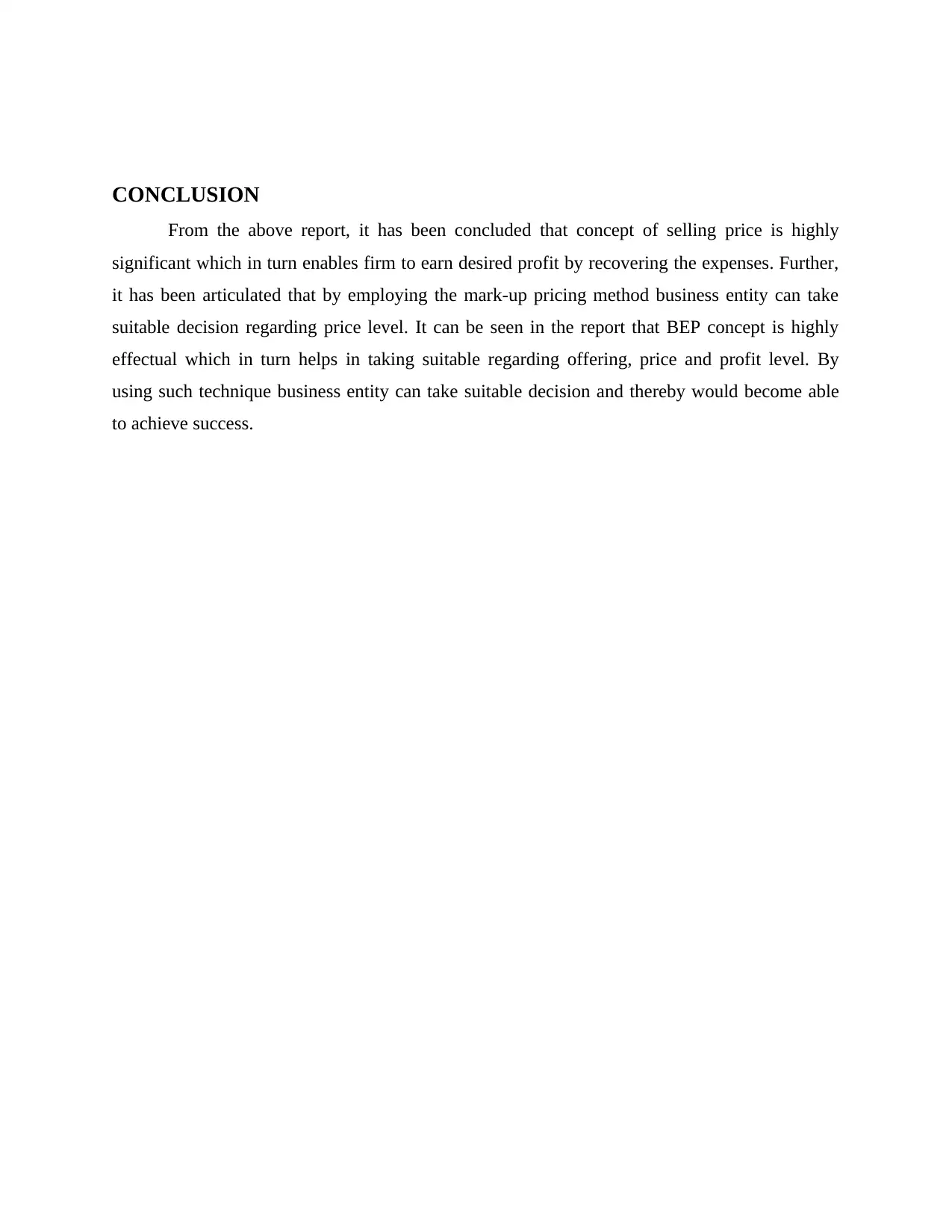
CONCLUSION
From the above report, it has been concluded that concept of selling price is highly
significant which in turn enables firm to earn desired profit by recovering the expenses. Further,
it has been articulated that by employing the mark-up pricing method business entity can take
suitable decision regarding price level. It can be seen in the report that BEP concept is highly
effectual which in turn helps in taking suitable regarding offering, price and profit level. By
using such technique business entity can take suitable decision and thereby would become able
to achieve success.
From the above report, it has been concluded that concept of selling price is highly
significant which in turn enables firm to earn desired profit by recovering the expenses. Further,
it has been articulated that by employing the mark-up pricing method business entity can take
suitable decision regarding price level. It can be seen in the report that BEP concept is highly
effectual which in turn helps in taking suitable regarding offering, price and profit level. By
using such technique business entity can take suitable decision and thereby would become able
to achieve success.
⊘ This is a preview!⊘
Do you want full access?
Subscribe today to unlock all pages.

Trusted by 1+ million students worldwide
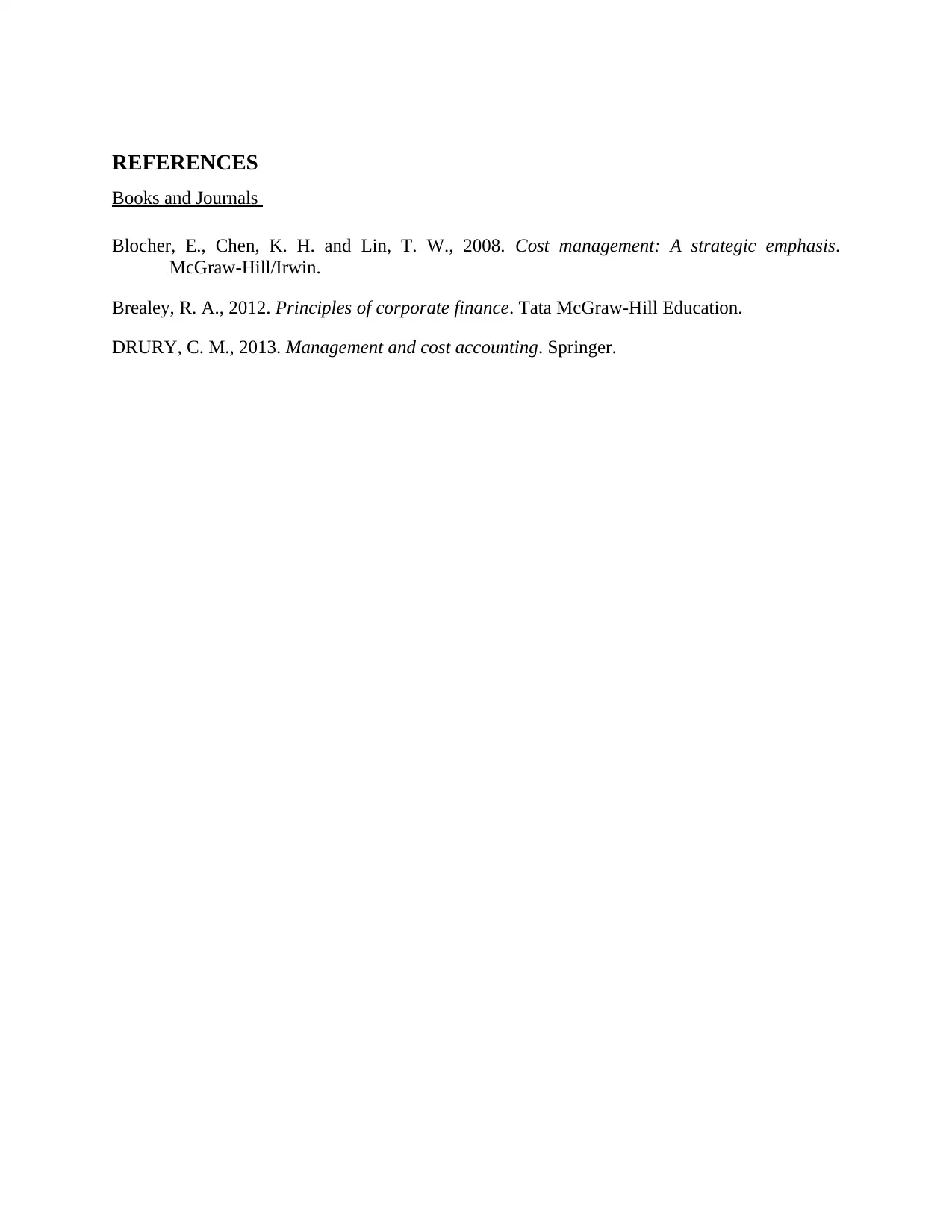
REFERENCES
Books and Journals
Blocher, E., Chen, K. H. and Lin, T. W., 2008. Cost management: A strategic emphasis.
McGraw-Hill/Irwin.
Brealey, R. A., 2012. Principles of corporate finance. Tata McGraw-Hill Education.
DRURY, C. M., 2013. Management and cost accounting. Springer.
Books and Journals
Blocher, E., Chen, K. H. and Lin, T. W., 2008. Cost management: A strategic emphasis.
McGraw-Hill/Irwin.
Brealey, R. A., 2012. Principles of corporate finance. Tata McGraw-Hill Education.
DRURY, C. M., 2013. Management and cost accounting. Springer.
1 out of 10
Related Documents
Your All-in-One AI-Powered Toolkit for Academic Success.
+13062052269
info@desklib.com
Available 24*7 on WhatsApp / Email
![[object Object]](/_next/static/media/star-bottom.7253800d.svg)
Unlock your academic potential
Copyright © 2020–2025 A2Z Services. All Rights Reserved. Developed and managed by ZUCOL.




